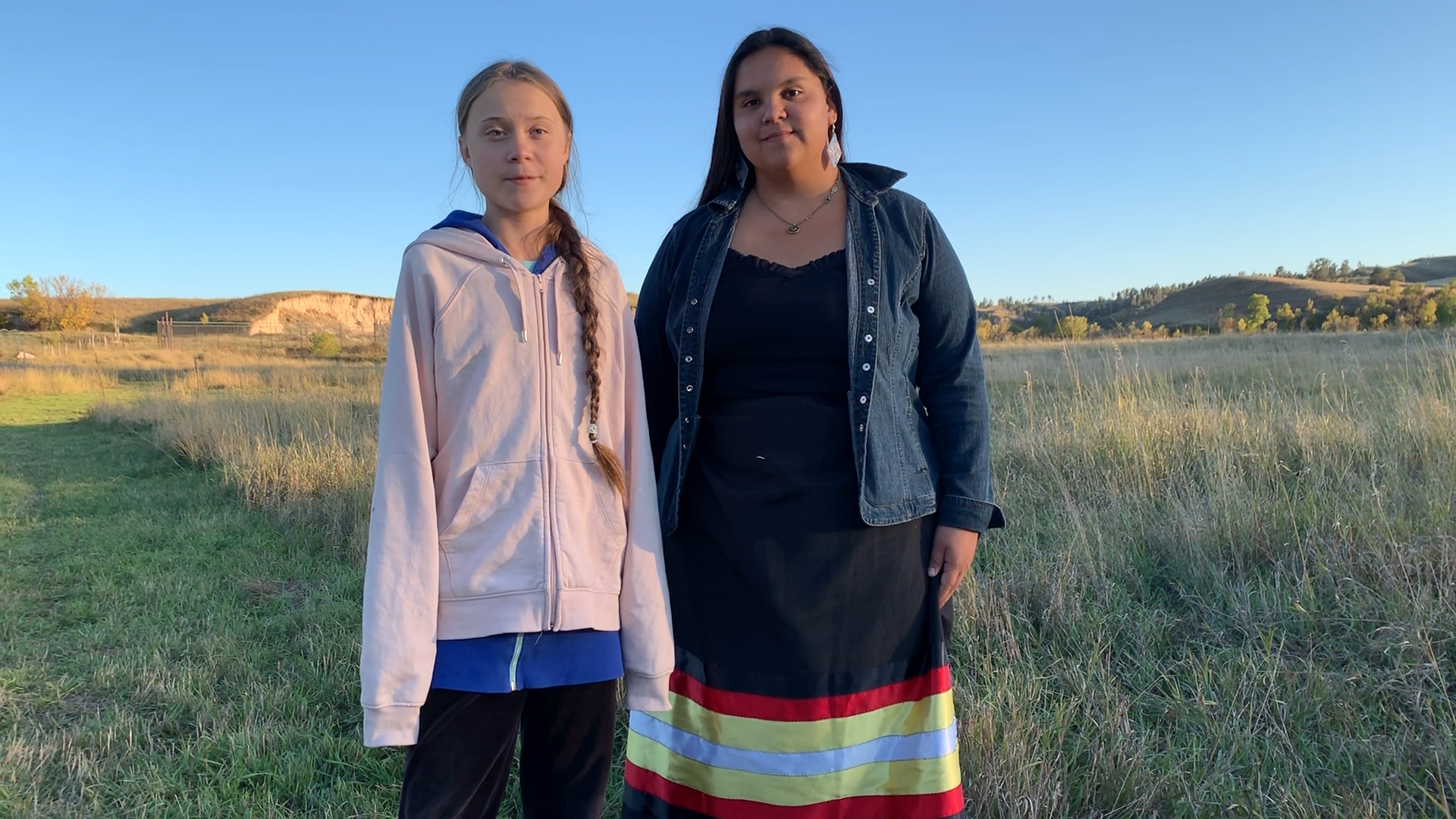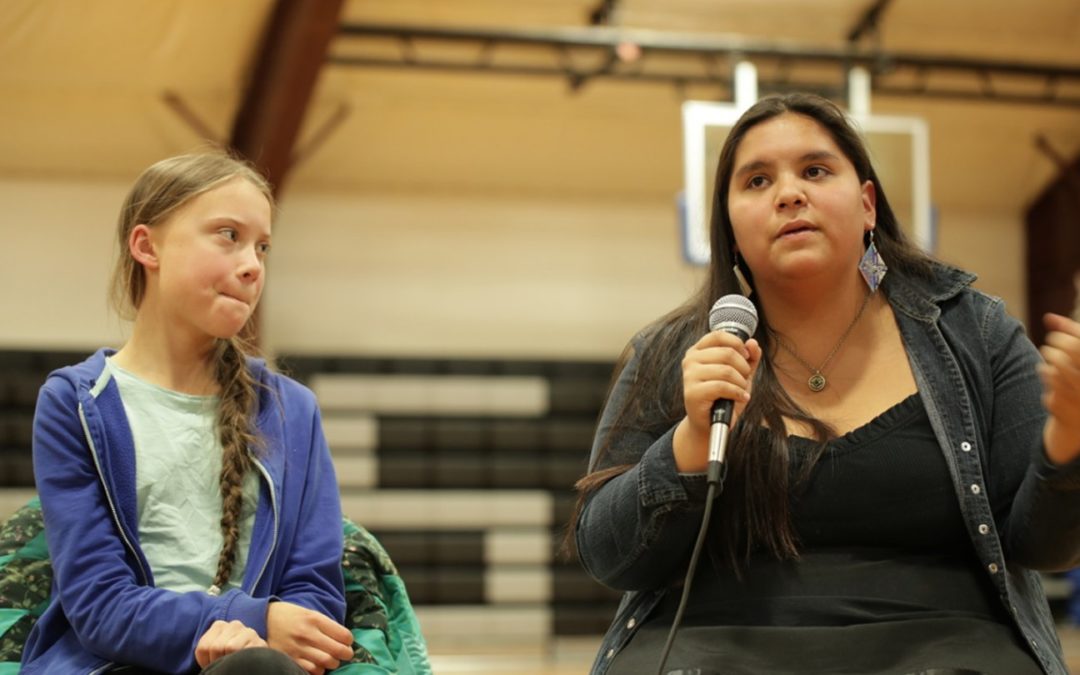Most of you have now heard about Greta Thunberg, the 16-year old Swedish climate activist who has barreled into the media over the last year. Greta striking alone in front of the Swedish parliament, inspiring millions of students to join her every Friday to protest for their future. And her impassioned UN speech where she asked the world leaders in the room ‘How Dare You?’
I was recently in Pine Ridge, on the homeland of the Oglala Lakota Nation, for Solve at Pine Ridge, which brought together the MIT Solve community, educators, students, and tribe members to celebrate sustainable tech innovation across Indian Country.
And Greta was there too, at a community event organized by the Oglala Sioux Tribe, the Lakota People’s Law Project, and Red Cloud Indian School—in conversation with Tokatawin Iron Eyes. Tokatawin, like Greta, is an impressive 16-year old climate activist, who cut her teeth at age 13 as one of the youth that began the Standing Rock #NoDAPL movement, protesting the Dakota Access Pipeline.
Over 250 mostly local Oglala Lakota community members fill the Red Cloud Indian School’s gymnasium. The event starts with a feed, prayers, song, and community leader speeches. When Greta appears, you notice she is smaller and quieter in person, but she immediately draws you in completely. Her message is simple: she is outraged about the facts of the climate crisis and thinks everyone, especially young people whose futures are being robbed before their eyes, should be outraged. She believes that through education, everyone will demand, seek, and find solutions. She complements Tokatawin to a tee, as they exchange reflections on the climate crisis, their work as youth activists, and the importance of indigenous peoples’ rights as a key part of the solution.
“We need to see the planet and nature as something which has a value of its own that we cannot own and exploit as we want,” says Greta. Tokatawin adds: “…If you are not including indigenous people in conversations and actions about solutions, the solutions that you create are not sustainable.”

Greta Thunberg and Tokatawin Iron Eyes on Pine Ridge Indian Reservation. Photo: Magdalena Wosinska / Lakota People’s Law Project
Following their conversation, in keeping with Lakota traditions, Julian Bear Runner, President of the Oglala Sioux Tribe, brings forth tribal members to bestow gifts to Greta. The most impressive is the huge star quilt. Star quilts are one of the most valued gifts of the Lakota people—gifting one is a sign of deep honor and respect and putting it around the recipient symbolizes protection on her journey through life. Tokatawin drapes the quilt over Greta, almost engulfing her in what I consider the most powerful moment of the evening.
Greta and Tokatawin understand all too well that time is running out, and that they are part of the generation that has no choice but to solve the world’s most pressing challenges—whether that is climate change, income inequality, hunger, or other persisting problems. In this sense, this generation echoes the words of Lyla June, poet and musician of Diné (Navajo) and Tsétsêhéstâhese (Cheyenne) lineages: “We are the change we have been waiting for. We are the ones our grandmas have been praying for.”
I call this Generation Solve.
And Generation Solve is not just about activism or famous 16-year-olds; it already counts millions of people from all backgrounds who are actively designing and implementing solutions to the challenges they see in their communities and around the world. As Greta says: “We need everyone to push from every possible angle in the right direction… you don’t really have a choice if you understand the urgency.” Generation Solve is also made up of scientists, technologists, innovators, entrepreneurs, community and civic leaders, artists, and educators.
Take Patrisse Vasek, a scientist and researcher at Oglala Lakota College, and a member of the Yankton Sioux Tribe. Her work centers around the health of indigenous lands and waterways that are facing the consequences of heavy metal leaching from abandoned mines.
And Generation Solve is not restricted by age. Gloria Lane and her family run Navajo Ethno-Agriculture, a hands-on native nonprofit educational farm along the San Juan River in northwest New Mexico, which passes along knowledge of preserved Navajo heritage crops and farming techniques through this unique teaching environment.
These innovators and activists, entrepreneurs and educators—those that make up Generation Solve—are in every country and community. Roya Mahboob is educating Afghani women through digital literacy and community building. Fohla Mouftaou from Benin is removing oil-based industrial pollution with fiber made from invasive water hyacinth plants. They, like Greta, Tokatawin, Patrisse, and Gloria, are on the front lines of the big issues facing humanity today. Sometimes we don’t look for them far enough, and often they have to do their work with far less resources than they need, but they are working tirelessly to solve the problems facing their community and the world.
There is no planet B and there is no one to turn to but ourselves to solve climate change and bring opportunity to all. We are the ones we have been waiting for, and whether we like it or not, we have no choice: we are Generation Solve.

